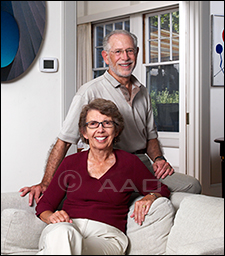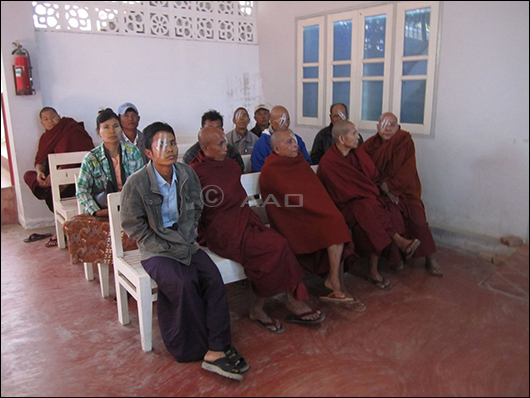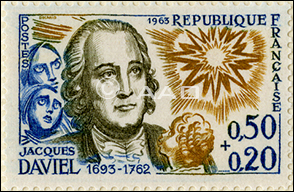What's Happening
Ophthalmology and the Arts: Interdisciplinary Lecture Added to Annual Meeting
 |
| NEW NAMED LECTURE. The Michael F. Marmor, MD, Lecture in Ophthalmology and the Arts will examine the role and relevance of the arts and history to ophthalmology. “My intent (and hope) with this lecture series is to encourage Academy members to step back briefly during each Annual Meeting to enjoy the arts or history through talks that are entertaining and that relate our work to the broader culture in which we live,” said Dr. Marmor, shown here with his wife, Jane B. Marmor, MD. |
The Foundation of the American Academy of Ophthalmology (FAAO) recently received a generous endowment from Michael F. Marmor, MD, and his wife, Jane B. Marmor, MD, through the Marmor Foundation, to establish the Michael F. Marmor, MD, Lecture in Ophthalmology and the Arts.
The lecture, to be delivered each year during the Annual Meeting, will provide an interdisciplinary educational presentation that examines the role and relevance of the arts and history to the nature, practice, and impact of ophthalmology. Those who attend the lecture will gain new insights into the connections between medicine, culture, and history.
The speaker will be chosen each year by the Annual Meeting Secretariat and a member of the Museum of Vision volunteer leadership. The speaker will be an authority on the arts or history with the ability to link this expertise with medicine, preferably ophthalmology.
Donate to the Foundation at www.faao.org/donate.
The Academy Joins the Choosing Wisely Campaign
On Feb. 20, the Academy announced its participation in the national Choosing Wisely initiative. The campaign, created by the American Board of Internal Medicine Foundation, aims to prompt conversations between doctors and their patients about efficient and appropriate care choices. These conversations should focus on identifying potentially unnecessary or even harmful medical tests and procedures.
To generate these dialogues, medical associations have produced lists of “Things Physicians and Patients Should Question.” With input from members and subspecialty societies that started last year, the Academy has identified five common ophthalmic tests and procedures that should be discussed with patients.
- Preoperative medical tests: Don’t perform preoperative medical tests—such as an electrocardiogram or blood glucose test—prior to eye surgery unless there are specific signs indicating a need for them.
- Imaging tests: Don’t routinely order imaging tests when there are no symptoms or signs of significant eye disease.
- Antibiotics for pink eye: Don’t prescribe antibiotics for pink eye that is caused by an adenovirus.
- Antibiotics for eye injections: Don’t routinely provide antibiotics before or after injections into the vitreous cavity of the eye.
- Punctal plugs for mild dry eye: Don’t treat mild dry eye by inserting punctal plugs before attempting other options, such as medical treatments with artificial tears, lubricants, and compresses.
David W. Parke II, MD, Academy Executive Vice President and CEO, discusses the list and its implications for ophthalmologists in a video on the Academy website. He emphasizes the importance of promoting responsible management of limited health care resources.
For more information, including a brief explanation of how the list was created, and to view Dr. Parke’s video, visit www.aao.org/one and select “Choosing Wisely” from the Practice Guidelines pull-down menu.
 ONE SPOTLIGHT: Transfer Your CME Credits to the ABO. To help members meet their American Board of Ophthalmology (ABO) maintenance of certification (MOC) requirements, the Academy and the ABO worked together to add a simple reporting feature to CME Central—the area on the ONE Network for reporting and tracking your CME credits. Take the following steps to transfer your Academy CME credits to the ABO instantly, eliminating manual entry. ONE SPOTLIGHT: Transfer Your CME Credits to the ABO. To help members meet their American Board of Ophthalmology (ABO) maintenance of certification (MOC) requirements, the Academy and the ABO worked together to add a simple reporting feature to CME Central—the area on the ONE Network for reporting and tracking your CME credits. Take the following steps to transfer your Academy CME credits to the ABO instantly, eliminating manual entry.
- Go to CME Central at www.aao.org/cme.
- Log in with your Academy username and password.
- Click on the “Review or claim CME online” button.
- Click on the “Transfer CME to ABO” button.
- Enter your five-digit ABO Diplomate ID number and click “Begin transfer.” If you don’t know your ID number, get it by logging into the ABO website: Click the “Login to your status page” button at the top of www.abop.org.
For more information, visit the Frequently Asked Questions at www.aao.org/cme, or e-mail moc@abop.org.
|
Academy Store
Practice Management Webinars
AAOE’s webinars help you run your practice more efficiently, code more accurately, and train your staff more effectively. If you missed a webinar, you can purchase an online recording or CD-ROM. Topics from the last several months include the following:
- 2013 ophthalmology coding updates
- Avoiding PQRS and e-prescribing penalties
- Protecting your online reputation
- Reducing patient wait times
- Understanding meaningful use and PQRS
- Improving billing performance
To order, visit www.aao.org/aaoeevents.
Meeting Matters
Sneak Peak: Skills Transfer Program
Looking to master new techniques? The Annual Meeting Skills Transfer Program provides hands-on instruction in a small class environment. Lab courses in 2013 will include Macular OCT, Phacoemulsification, and Advanced Techniques in Endothelial Keratoplasty Surgery.
The Annual Meeting Skills Transfer Program also provides several courses specifically developed for residents such as Laser Refractive Surgery, Glaucoma Filtration Surgery, and Phacoemulsification and Advanced Techniques Lab for Ophthalmology Residents.
Session listings will be available online starting in June. Skills Transfer labs are ticketed events that must be purchased separately. Many labs have a prerequisite lecture included in the ticket price.
For more information, visit www.aao.org/skills.
See You in New Orleans
New Orleans is known for the French Quarter, delicious food, and incredible jazz. It is also home to unique art collections at the New Orleans Museum of Art and the Ogden Museum of Southern Art.
In addition, check out the art demonstrations at the New Orleans Glassworks and Printmaking Studio (featured twice on the NBC “Today” show), where you can experience a hands-on, two-hour course. Learn to design wine glasses, print wine labels, and create copper enameling.
For more New Orleans recommendations, visit www.aao.org/2013.
Hotel Meeting Space Requests
Would your alumni or ophthalmic society like to meet during this year’s Annual Meeting in New Orleans? Hotel meeting space requests are now being accepted. Assignments will be made on a first-come, first-served basis.
For details, including hotel options, meeting times, and processing fees, visit www.aao.org/meeting_space.
ASCRS: Stop by the Academy’s Booth
Visit the Academy at Booth 334 during the American Society of Cataract and Refractive Surgery (ASCRS) 2013 Symposium and Congress. You can view the latest Academy products, get information about the 2013 Academy Annual Meeting, or have your membership questions answered. The ASCRS meeting will be held April 19 to 23 in San Francisco.
D.C. Report
2013 State Legislators
The majority of state legislatures are considering legislation that has the potential to affect patient safety and quality of care. The Academy has identified key issues before lawmakers this year and is encouraging members to join with their state ophthalmic societies to ensure that the interests of patients and the profession are represented and protected as legislation is debated.
Optometric scope expansion. Optometrists are pushing to expand their scope of practice during this legislative cycle. Legislation varies by state. However, a widespread threat is the unprecedented push by optometry to gain surgical privileges in multiple states. In Nebraska and Tennessee, for example, optometrists want injection and lid surgery privileges. Besides expanding their scope through legislation, optometrists are also seeking surgical authority through regulations adopted by state boards of optometry. In some states, optometrists are pursuing new or expanded prescription authority. The Academy is working with the state ophthalmic societies to educate lawmakers about the severe risks these proposals present to patient safety and quality of surgical care.
Compounded products. Compounding pharmacies and their products have vaulted to a high priority for state public policy in 2013 as a result of a deadly, multistate meningitis outbreak last year linked to the New England Compounding Center. As a result of the crisis, federal and state lawmakers and regulators are scrutinizing public safety policies related to compounded products. Sixteen states currently have statutes or regulations that require a patient-specific prescription for compounded medications, and many other states are considering tightening requirements. The Academy is working with state ophthalmic societies to educate lawmakers and regulators about this restriction, which limits office use of safely compounded products and creates access problems to the drugs patients need.
Children’s vision. States are in the process of implementing the federal health care reform law, including the mandate that health plans participating in state insurance exchanges contain certain essential benefits such as pediatric vision services. The Academy is encouraging state ophthalmic societies and medical associations to partner with one another and help policymakers establish both state and federal children’s vision screening benefits.
Truth in advertising. The Academy and state ophthalmic societies are proactively seeking passage of truth-in-advertising bills intended to ensure that patients know who is providing their health care. This legislation requires health care providers to disclose their educational background and qualifications.
To track legislation, visit www.aao.org/advocacy and click the “State Tracker” link.
Members at Large
People
On Feb. 1, Gholam Peyman, MD, received the National Medal of Technology and Innovation at the White House. He was honored by President Barack Obama along with 10 other inventors. This award is the highest honor the government gives to scientists, engineers, and inventors. Established in 1980, it recognizes outstanding innovations and contributions.
Dr. Peyman is an ophthalmologist, surgeon, and professor at the University of Arizona. He is an innovator who has developed a variety of medical devices, surgical techniques, and treatment methods. He has won many honors and awards, including the Academy’s Lifetime Achievement Award.
David Ringel, DO, will deliver the Joseph H. Wyatt, DO, Lecture during the Annual Clinical Assembly of the American Osteopathic Colleges of Ophthalmology and Otolaryngology–Head and Neck Surgery Foundation at the Hyatt Regency Grand Cypress in Orlando, Fla., May 8 to 12. The lecture recognizes a pioneer in osteopathic ophthalmology in memory of Dr. Wyatt, founder of the Detroit Osteopathic Ophthalmology Consortium.
Rajesh C. Rao, MD, Jeffrey H. Stern, MD, PhD, Russell N. Van Gelder, MD, PhD, and Janey L. Wiggs, MD, PhD, were among the 10 winners of the Challenge to Identify Audacious Goals in Vision Research and Blindness Rehabilitation sponsored by the National Eye Institute (NEI). The competition aimed to gather creative ideas to solve or reduce vision problems worldwide within 10 years.
The submissions were narrowed by more than 80 experts and then judged by a federal panel of 13 clinicians and scientists. Each winner received a $3,000 prize as well as travel expenses to attend the NEI Audacious Goals Development Meeting in February.
Following are the winning submissions from Drs. Rao, Stern, Van Gelder, and Wiggs, respectively:
- An Audacious Goal: Reprogramming the Retina. To directly reprogram easy-to-isolate skin or blood cells to retinal cells using gene therapy and other techniques to enable repair strategies for degenerative retinal diseases.
- Endogenous Retinal Repair: Releasing Our Inner Salamander. To repair the retina by activating stem cells residing within the eye, awakening reparative processes that occur naturally in amphibians and other animals but that lie dormant in human patients.
- Reversing Retinal Blindness Using Small Molecules. To restore vision to patients with retinal diseases through the use of a photoswitch, a small molecule that is chemically modified to become active or inactive after exposure to certain wavelengths of light.
- Vision BioBank—A Network of Ocular Phenotyping Centers Using Genomic and Epidemiologic Data to Promote Personalized Ophthalmology. To create a network of biobanks that collect corresponding phenotype and genotype data from people with certain eye diseases.
Wisconsin Academy’s Myanmar Adventure
On Jan. 18, representatives from the Wisconsin Academy of Ophthalmology (WAO) flew to Myanmar on a two-week medical mission. The group included WAO Executive Director Richard Paul, resident members Justin Yamanuha, MD, and Kweku Grant-Acquah, MD, and members Arvind Saini, MD, Kevin P. Wienkers, MD, Robert D. Sullivan, MD, and Vernon C. Parmley, MD, along with his son Michael, who is in medical school.
“Myanmar has more than 55 million people and one of the highest published blindness rates in the world, with 50 percent of the population living below the UN poverty line. The WAO was thrilled to have the opportunity to send a group of members on a cataract surgery mission,” said Deborah Bernstein, MD, WAO president.
Surprises. It is estimated that Myanmar has a backlog of 600,000 cases. Before the WAO team departed, they had hoped to perform 325 cataract operations in two locations: the Sitagu Hospital, in Sagaing Hills (near Mandalay), and the Metta Clinic, in a rural area near the Inle Lake region. “We quickly realized during our time at Sagaing Hills that our goals were overly ambitious. We completed 53 cases during that first week and conducted several times that number in eye exams. Some obstacles we encountered included the language barrier, which definitely slowed down the OR,” said Dr. Saini.
“Another limiting factor in Sagaing Hills was that patients were waiting to assess our team’s outcomes before they committed to seeing us, since a number of foreign physicians rotate through this particular clinic. However, we were pleasantly surprised at how well supplied and well staffed the hospital was in Sagaing, including three working phaco machines. We brought everything with us, only to find that they had a good inventory of intraocular lenses and other supplies onsite,” said Dr. Saini.
 |
SITAGU HOSPITAL. Postoperative patients in the waiting room at the Sagaing clinic.
|
Insights. In the second week at the Metta Clinic—located in a very underserved area—the WAO team performed 67 cataract surgeries (all ECCE) and examined hundreds of potential patients, some coming from hundreds of miles away. Dr. Wienkers said he had never seen so many white, mature cataracts. “These people are so gentle and appreciative. It reminds me of why I chose ophthalmology, and I would definitely go again. I encourage anyone who truly wants to make a difference to join the WAO in helping these wonderful people,” he said. Dr. Parmley pointed out that evolving training methods in the United States may have an impact on the ability to treat cataracts in the developing world. He said, “I wonder if American ophthalmologists will still be able to help with this kind of work in 10 years as extracapsular-trained surgeons fade away.”
The WAO partnered on this effort with the Global Community Service Foundation (GCSF) and Lions International. Dr. Saini said, “You really realize the importance of a good, stable health care system and how crucial it is to provide sustainable care and have good training programs. It was heartbreaking to see patients who could have been helped if they had been seen earlier, including the four-year-old girl with advanced glaucoma for whom we could do very little. We hope to return, as there is much more to accomplish. A real impact will only be made with repeat visits, establishing relationships and building trust with the medical institutions and patients over time.”
The mission team was hosted in Myanmar by the Sitagu International Buddhist Academy, headed by the Venerable Dr. Ashin Nyanissara—the most senior monk in the country. The Sitagu organization has invited WAO to establish a long-term relationship with them with visits to their 20 hospitals throughout the country.
 MUSEUM: THIS MONTH IN OPHTHALMIC HISTORY. On April 8, 1747, French ophthalmologist Jacques Daviel, MD (1696-1762), performed the first modern cataract surgery by making a corneal incision to remove the lens. The procedure required several instruments, including a corneal knife, forceps or scissors, a blunted needle, a spatula, and a spoon. Dr. Daviel recommended using the fingers so that the “cataract is gently pushed into the anterior chamber and from there onto the cheek.” Postoperatively, the eyes were bathed in a mixture of water and wine and covered by a cotton dressing. Patients were required to lie on their backs in a darkened room for approximately eight days. In 1752, he reported on his cases to the French Royal Academy of Surgeons, instigating the evolution of modern cataract surgery and a new era in ophthalmology. MUSEUM: THIS MONTH IN OPHTHALMIC HISTORY. On April 8, 1747, French ophthalmologist Jacques Daviel, MD (1696-1762), performed the first modern cataract surgery by making a corneal incision to remove the lens. The procedure required several instruments, including a corneal knife, forceps or scissors, a blunted needle, a spatula, and a spoon. Dr. Daviel recommended using the fingers so that the “cataract is gently pushed into the anterior chamber and from there onto the cheek.” Postoperatively, the eyes were bathed in a mixture of water and wine and covered by a cotton dressing. Patients were required to lie on their backs in a darkened room for approximately eight days. In 1752, he reported on his cases to the French Royal Academy of Surgeons, instigating the evolution of modern cataract surgery and a new era in ophthalmology.
Learn more about Dr. Daviel at www.museumofvision.org/bios. |